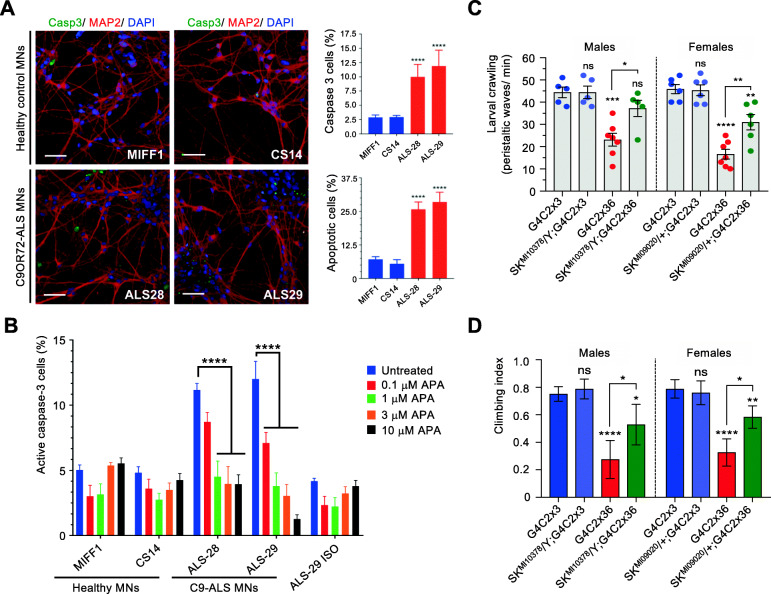Fig. 6.
Pharmacological and genetic manipulation of KCCN channels promotes C9-ALS MNs survival and Drosophila locomotor function. A High content images of caspase 3 and MAP2 positive motor neurons from two control (MIFF1 & CS14) and two C9ORF&2-ALS (ALS-28 & ALS-29) lines. Scale bars: 50 μm. Bar charts represent the percentage of caspase 3 positive cells (top right) and of apoptotic cells measured by nuclear fragmentation (bottom right) in healthy and C9-ALS patient-derived motor neurons (mean ± SEM; one-way ANOVA Tukey’s multiple comparison test, ****: p < 0.0001; N (replicate experiments) = 3). B High-content microscopy automated imaging quantification of caspase-3 positive cells (%) treated with DMSO or increasing concentrations of the KCNN1/3 inhibitor apamin (APA) in healthy, C9-ALS and isogenic CRISPR-Cas9 mediated deletion of the repeat expansion (ISO) patient-derived motor neurons (mean ± SEM; two-way ANOVA Tukey’s multiple comparison test, ****: p < 0.0001; N (replicate experiments) = 3). C Larval crawling ability of male and female control (G4C3x3) or C9-ALS (G4C2x36) Drosophila crossed or not with two different SK mutant lines driven by nSyb-GAL4 (mean ± SEM; one-way ANOVA; ns: non-significant, *: p < 0.05, **: p < 0.01, ****: p < 0.0001; N (Drosophila larvae) > 5). D Climbing ability of male and female control (G4C3x3) or C9-ALS (G4C2x36) Drosophila crossed or not with two different SK mutant lines driven by D42-GAL4 (mean ± 95% CI; Kruskal-Wallis with Dunn’s correction; ns: non-significant, *: p < 0.05, **: p < 0.01, ****: p < 0.0001; N (Drosophila flies) > 25)

